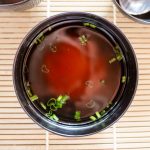
Misoshiru, is a classic Japanese miso soup, and you might know it from your Japanese restaurant.
Here you will learn everything to make misoshiru from scratch at home. Tips and instructions from a Japanese home cook and restaurant owner.
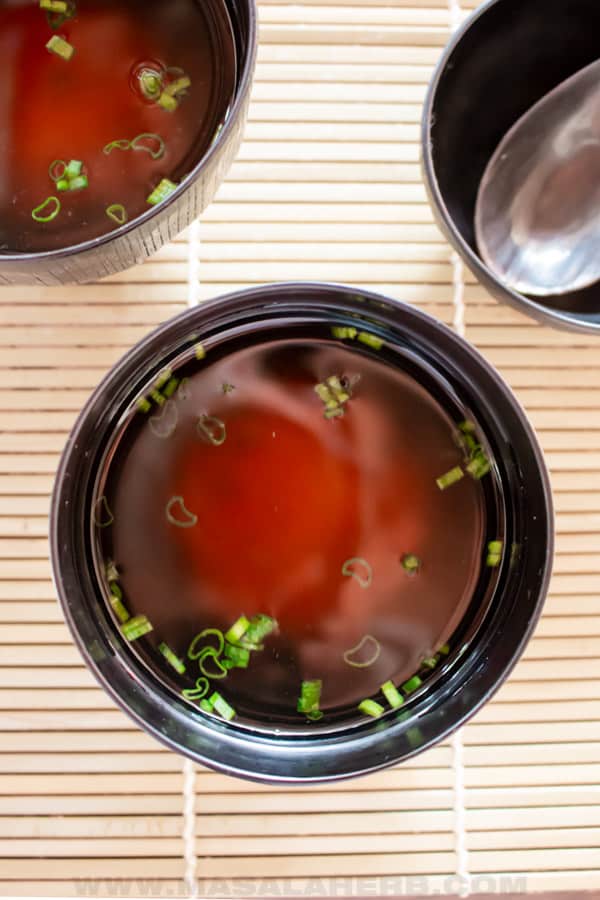

Global Food Recipes
with Spices and Herbs
Free E-Book available for a limited time. Grab yours now and get instantly inspired!
You missed out!
Momoko shows you in this recipe the basic steps to make an easy Japanese miso soup from scratch in a saucepan.
Jump to:
📕 What is misoshiru?
Misoshiru is a traditional Japanese Soup made with miso, a fermented soybean paste from Japan.
Variations of miso paste exist, such as red miso, yellow and white miso. Regional Japanese miso paste varieties are prepared with fermented barley too.
Misoshiru is a quick clear soup, prepared with miso paste and other ingredients and varieties of miso soup are common.
The paste is used to make an instant soup. It only takes 5 minutes to make a bowl of miso soup.
🥣 Ingredients
Here are some pointers on what to look out for when making miso soup from scratch.
Miso Paste
Miso paste is the main ingredient, and you can choose to use your type of miso such as red, yellow, or a white miso paste.
Red miso paste is more common, white miso paste is usually considered superior in taste.
Mixing red and white miso paste can result in interesting soup flavors and is encouraged.
You can buy miso paste in a specialized Asian grocery store or get miso paste online.
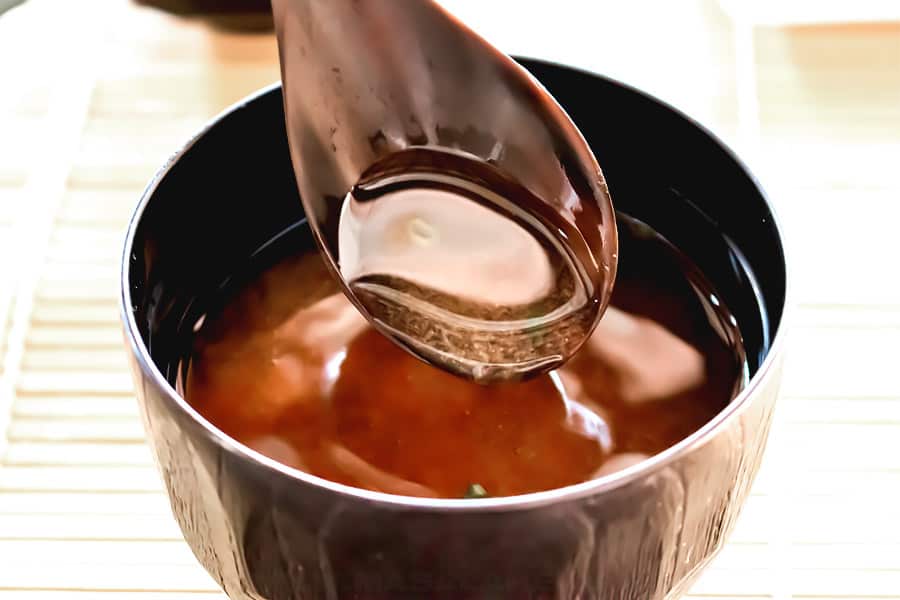
Dashi
Classic misoshiru soup is based on dashi, which is a Japanese broth.
Dashi can be made of bonito flakes (dried fish flakes), kombu seaweed, wakame seaweed kelp, and dried shiitake mushrooms among other variations.
The best and most flavorful dashi is made with bonito flakes and kombu kelp and that one is known as awase dashi.
We are making shiitake dashi, in today's misoshiru soup bowl recipe. Today's recipe is a plant-based vegan miso soup variation.
If you don't have dashi on hand, then you can use a regular broth, but the taste will be different, and it won't make an authentic miso soup.
In that case, use instant cubes or flakes or liquid broth (Japanese version preferred above western broth).
The better option (vs western broth) is to use instant dashi powder in heated water!
Extra Flavoring
Soy sauce, some sugar, and salt can be added as well for extra flavor. Sliced green onion stalks can be used as a garnish.
Extra ingredients are not required if you are using a high-quality miso paste.
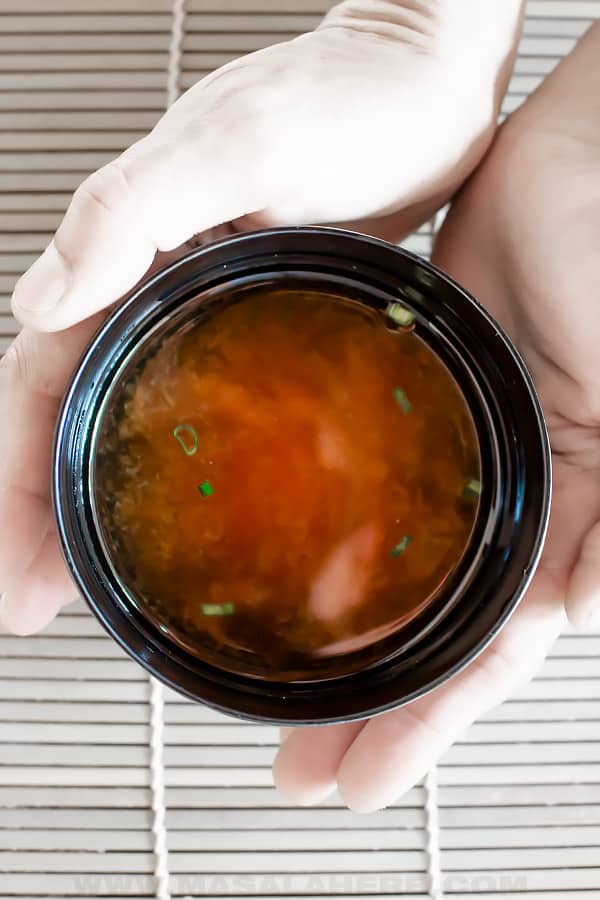
🔪 How to make it?
A homemade misoshiru soup essentially consists of 2 parts: the making of the dashi and the miso soup itself.
The focus today is a vegan dashi prepared with shiitake mushrooms.
Luckily, making dashi and the soup is easy. Here is how in a nutshell (full recipe in the recipe card further below).
Watch the how-to video to help you along.
Step 1
Make dashi by keeping the mushrooms to soak in water for a few hours.
Take out mushrooms before using the dashi for the soup.
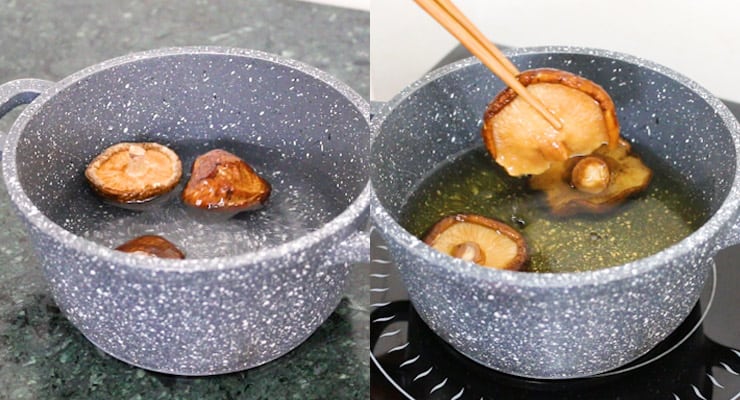
Step 2
Simmer dashi over a medium heat setting and add flavoring ingredients when it's cooking.

Step 3
Reduce or turn off the heat and add in the miso paste. Combine paste into soup until it has dissolved.
Tip: Miso paste shouldn't boil in the soup or the flavors of the miso will get altered in a not so good way.
Pour into a bowl and garnish with green onion slices or scallions and serve up hot.
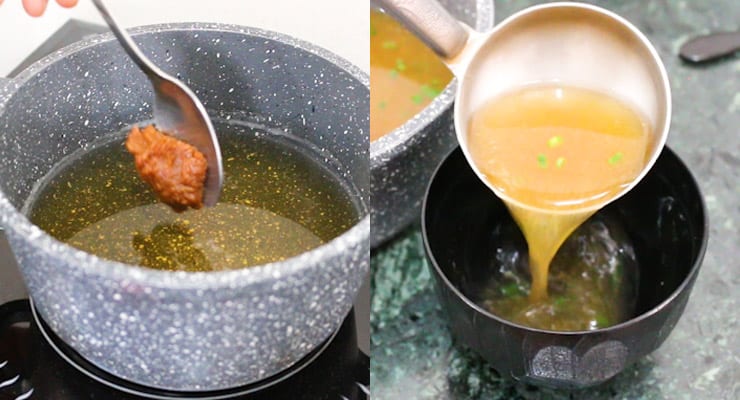
📜 Soup Additions
This is the most classic, simple, and basic misoshiru out there, and you can add ingredients and modify it to your needs.
Add the following to your soup, while the soup is cooking or to garnish, one at a time or combined:
- noodles – ramen, udon, soba
- tofu – uncooked in the soup or crispy fried as a topping. You can use silken tofu too.
- seafood – clams, surimi, crab, shrimp
- meat – stir-fried pork or chicken
- vegetables – radish, carrot, leek, potato, sweet potato, taro root, eggplant, cabbage, bok choy or green peas
- shimeji Mushrooms
- drop an egg in or serve with soft-boiled egg half (Ajitsuke Tamago)
🍲 Serving
Traditionally, Japanese homes enjoy miso soup mainly for breakfast with a bowl of rice and other small healthy seafood and vegetable bites.
However, a bowl of misoshiru soup is also served up for lunch and dinner the same way as for breakfast.
The combination of miso soup and sushi rolls is a great idea too.
Serve up your clear Japanese soup with a bowl of plain cooked rice, if you have the flu, a hangover or if you want to lose weight (probiotic properties).
The soup is low calorie, so it makes a great accompaniment with most Japanese themed meals.
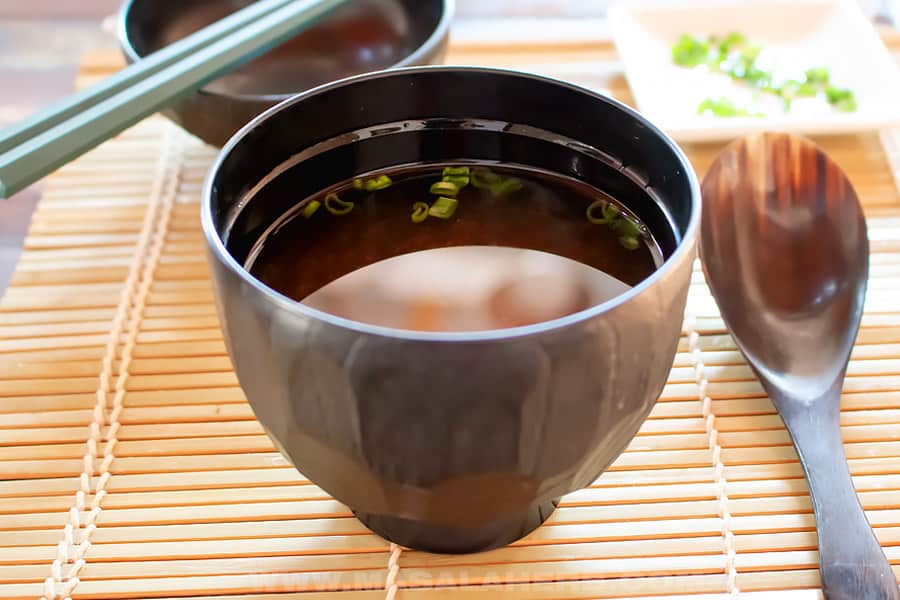
💭 FAQs
You can keep your miso soup for up to 2-3 days in your fridge.
I don't recommend freezing miso soup because thawing would take longer than making it from scratch. Instead, I suggest you prepare dashi and freeze that in batches. That way you can make miso soup quickly.
Miso soup tastes, salty, fruity, umami and a bit sour. You can enrich the flavors by adding more ingredients.
Miso paste may contain barley or wheat. It's only gluten-free if advertised on the packaging. This is a basic vegan miso soup recipe.
👁️ More Recipes like this
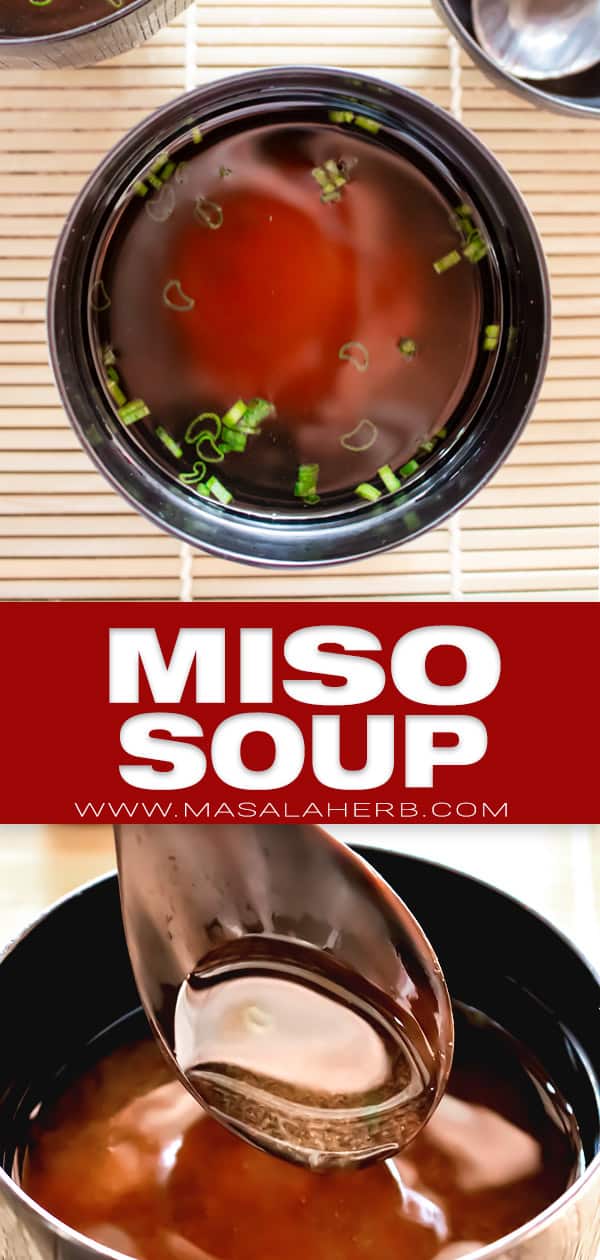
📖 Recipe
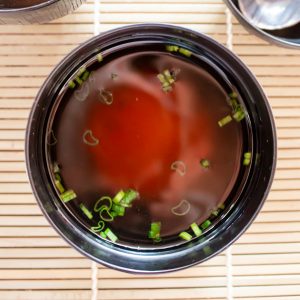
Basic Misoshiru Recipe
Ingredients
For the Mushroom Dashi:
- 2 Cup Water
- 3 Dried Shiitake Mushroom medium
- 1x1 Inch Kombu optional, *see Notes
For the Misoshiru:
Instructions
- For the dashi keep water and dried mushrooms to soak. If you have kombu seaweed, add that too. Keep soaking for at least 2 hours (we soaked 6 hours). If you are rushing, soak with warm water for 30 minutes.2 Cup Water, 3 Dried Shiitake Mushroom, 1x1 Inch Kombu
- When done soaking, discard mushrooms (and kombu if you added that earlier). Keep dashi on the stove top and heat up.
- The dashi will form foam. Skim foam with a fine mesh.
- Add soy sauce, sugar, and salt to the dashi and combine while it's still cooking.1 Teaspoon Soy Sauce, 1 Teaspoon Sugar, ½ Teaspoon Salt
- Reduce heat completely or take from the heat when it's bubbling and stir in the miso paste. Mix paste into your hot misoshiru soup.1 Tablespoon Miso Paste
- Take miso soup from the heat, garnish with sliced green onion stalks and serve hot.Green Onions
Notes
- You can use ready-made dashi too and skip the 6 hours soaking time. OR prep the dashi in a larger batch in advance.
- You can add kombu, it's optional. The recipe video doesn't include kombu. Kombu with shiitake is a great combination and gives a lot of flavor to the soup. To use the kombu, just take it once through running water and add to the water with the mushrooms.
- Use red or white miso paste or mixed. If you are using a high quality flavorful miso, you won't need to add the soy sauce, sugar, and salt. Never boil the miso paste or else it will change the flavor of your soup. Add at the end so that the miso paste won't get accidentally boiled.
- You can choose to add more ingredients during the cooking process (but before the miso past is added, fermented paste always at the end), such as tofu, vegetables, meats, seafood. See post for ideas.
- The servings are small Japanese sized bowls. Two of these Japanese servings equal 1 large serving in the West.


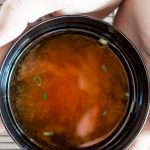
I wouldn’t want the mushrooms to go to waste. I can eat them still, right?
You can use them but I would cook them first. So for example you can cut them into strips and add them to a frying pan with eggs or something else. Or add them to another soup.
Lovely 🥰
fantastic! glad you liked it 🙂
Could I use fresh mushrooms instead of dried? I couldn't find the dried ones I usually get for this at the store.
No I'm sorry. Only dried shiitake mushrooms will give enough flavor to your dashi. Fresh shiitake mushrooms won't make it flavorful enough. In the post I talk about alternatives. You could switch the mushrooms with kombu seaweed or bonito fish flakes.
This was very soothing and not gonna lie inspiring because it was so easy, thank you, i plan to make this soon
Glad you enjoyed the miso soup faith. thanks for sharing 🙂
Omit salt, too salty. Otherwise, very good recipe.
Hi Paula, it depends on the quality of your miso paste if you need to add salt or not. I talk about that in the notes section in the recipe card. The salt can be omitted if you use a good quality miso paste. Thanks for your feedback!